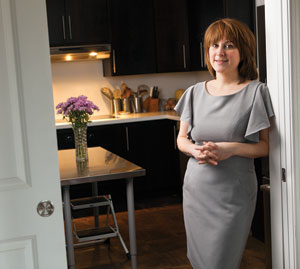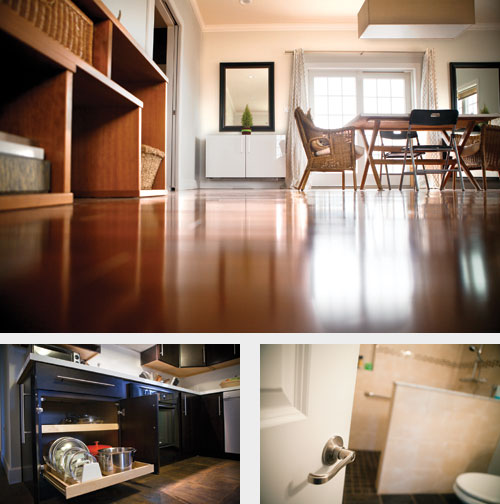Esther Semsei Greenhouse '93, MS '03, promotes environments that can last a lifetime
Esther Semsei Greenhouse '93, MS '03, promotes environments that can last a lifetime
Walk through Esther Semsei Greenhouse's garage door, through the laundry room, and into the kitchen, and nothing about the two-story, 2,300-square-foot Ithaca home seems particularly unusual.
But sit in a wheelchair and roll through the front door, into the capacious foyer and adjoining living room, and the differences from most residential construction are happily apparent. The passageways between rooms accommodate the chair's girth and turning radius. The floors are free of area rugs and other surfaces that could impede wheels or increase the risk of a fall. The lightweight double doors separating the multi-purpose den and guest room from the entryway have levered handles; they're easy to open and close, from a chair, with limited hand strength. Even the full bath and kitchen boast features welcoming to someone in a wheelchair. "This is a home for a lifetime," says Greenhouse '93, MS '03, "for everyone."

The petite brunette, an independent consultant on elder- and disability-friendly design and policy, is just forty-one years old. She gets around fine sans assistive devices, as do her husband, custom builder Brooke Greenhouse '91, and their twelve-year-old son. Yet when the Greenhouses started planning their home (and one next door for her mother), they zeroed in on three guiding principles—durability, energy efficiency, and accessibility—to insure that each family could enjoy the results over the long haul. "A typical house requires changes because the family situation changes or new owners move in," she says. "Why throw away perfectly good building materials, all because you didn't plan?"
Beyond its ecological merits, thinking ahead contains costs and makes life easier for all concerned, says Greenhouse, who teaches courses on "aging in place" for the National Association of Home Builders and serves on AARP's Boomer Project Universal Design Consumer Task Force. Long-lasting, high-efficiency LED bulbs in the living room ceiling fixtures come with an initial price premium—but in addition to accruing lower lifetime electricity costs, they last for decades, reducing the risk that someone will stumble about in the dark when one fails or fall from a ladder while replacing it. The brushed-nickel cabinet pulls work equally well with a closed fist or a firm grip; arthritis won't necessitate new hardware. The benefits of universal design are even clearer when it comes to the first-floor doorways—while the wide doors for the bathroom and den cost the Greenhouses an extra $20 each, the average cost nationwide to retrofit a single doorway to accommodate a wheelchair is $700. "Why isn't every new house built with wider doorways?" she asks. "It's not just about accommodating someone in a wheelchair, it's carrying a laundry basket or a baby."
Greenhouse credits application materials from the College of Human Ecology's Department of Design and Environmental Analysis with introducing her to the ways in which design promotes or impedes function. "It was like the heavens parted," she says. "I got goose bumps." Reading about blighted urban neighborhoods where crumbling sidewalks stranded aging residents in their homes cemented her path. "It really resonated. I decided I wanted to enable people through the environment, take those obstacles out of the way." She earned a certificate in gerontology and, at twenty-one, resolved to promote "enabling design," which allows independent living for people with a wide range of physical abilities.
It's a concept whose time has come. Last year, America's 78 million Baby Boomers started turning sixty-five. Over the next quarter century, nearly 75 million people will become Medicare eligible. "The median annual cost for nursing home care is $73,000,"says Greenhouse. "I'm trying to get people to see this as a policy issue: if fewer people go into nursing care, society saves."

Yet getting young, fit consumers to consider accessibility can be a hard sell. Greenhouse often begins her classes for builders by asking how many consider themselves "disabled." Few raise a hand. Then she reveals her own physical limits—her short stature and a collarbone broken at birth that limits her shoulder strength. Lastly, she asks her students how many wear eyeglasses or contact lenses. Invariably more than half raise their hands. "They're visually disabled and use an assistive device every single day," she says.
To drive her point home, Greenhouse introduces the concept of "environmental press"—the notion that a gap between what the environment demands and a person's body can achieve creates physical stress that exacerbates the situation. Think of a child clambering onto a countertop to reach a cupboard, a person with poor balance climbing into a tub, or an arthritis sufferer whose nutrition declines because the kitchen is too difficult to navigate. Helping consumers consider such matters ahead of time boils down to marketing, she notes. "What you call something means the difference between what's acceptable or not," she says. "Call it a Roman shower and it's very popular; call it a roll-in bath and people have no interest."
The Greenhouses use their combination den and guest room every day for TV viewing and lounging. And in the six months after moving into their new home, they hosted three guests unable to mount the stairs: the first-floor room and accessible bath preserved complete independence for each. It turns out the luxe design has made Greenhouse's daily life easier, too. She's used the tiled Roman shower to scrub patio furniture, water plants, and rinse window screens without getting drenched. If Harry, the family's shelter pup, weren't terrified of water, Greenhouse says she'd probably use it to bathe him, too. "Having an aesthetically pleasing house and an enabling design are not mutually exclusive," she says. "There's that old adage, 'Form follows function.' You can have both."


